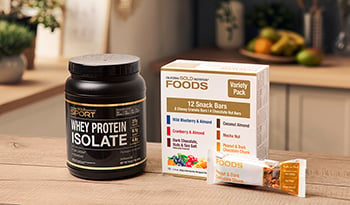Tips for Healthy Snacking
DISCLAIMER:This blog does not intend to provide diagnosis...
- In this article:
- 5 Easy Healthy Snack Ideas

Most adults in the United States consume about 400 to 500 calories daily in snack foods—almost all empty calories that may fuel inflammation and help pack on excess weight. The good news? You can satisfy your snack attack and boost your health. So, let’s dive into your next bite.
5 Easy Healthy Snack Ideas
1. Dark Chocolate
Dark chocolate (50%—90% cacao or higher) contains no milk, has less sugar, and is more nutrition-packed cocoa than milk chocolate. The high dose of cocoa delivers flavanols that help relax blood vessels and polyphenols that help lower levels of the stress hormone cortisol. A study in PLOS: Global Public Health found that eating an ounce a day of 85% dark chocolate boosts your mood by feeding good-for-you gut bacteria that power up the gut-brain communication network.
Dark chocolate also delivers important minerals: iron, magnesium, zinc, copper, and phosphorus. According to the Cleveland Clinic, these can support immunity (zinc), help keep bones and teeth healthy (phosphorus), and improve your sleep quality (magnesium). You also get gut-friendly fiber—about 4g per ounce! Aim for one ounce of 70%-85% dark chocolate, containing about 170 calories.
Unfortunately, the worldwide chocolate supply is being threatened by a virus that attacks the trees and the seed pods from which chocolate is produced. So, you want to stock a pantry full of other snacks that satisfy your cravings while improving your health.
2. Mixed Nuts
When you are on the go, nothing is easier—or more energizing—than grabbing an ounce of mixed nuts, containing a mixture of walnuts, cashews, almonds, and pecans. An ounce eaten most days of the week will provide you with a good supply of ALA omega-3 fatty acids that may help tamp down inflammation. It also helps support heart health. Surprisingly, while an ounce of mixed nuts delivers around 175 calories, if they’re dry-roasted, they deliver about 168 calories.
3. Apples and Peanut Butter
Apple slices can act as “crackers” that deliver the peanut butter. They contain various nutrients, including vitamin C, copper, and lots of gut-friendly fiber. As for the peanut butter, make sure it’s 100% peanuts with no added sugars or chemicals—check the ingredients label. Peanut butter provides protein, fiber, and some healthy fats. Calories: Two tablespoons contain around 200 calories. Half an apple contains around 60 calories.
4. Veggies and Dip
Cut a whole sweet red bell pepper into strips to use as chips to scoop up the guacamole. The red bell pepper contains fiber, potassium, and 253% of the daily value for vitamin C! Guacamole delivers some fiber, a load of monounsaturated fat, and a touch of vitamin C, E, K, and folate. Calories: The combo of the bell pepper and 4 tablespoons of guacamole provides around 200 calories.
5. Yogurt and Fruit
Yogurt can be a healthy snack if you opt for low- or no-fat milk-based yogurt or a plant-derived yogurt. Avoid pre-flavored or fruit-and-sugar-added varieties. A serving of low-fat, milk-based Greek yogurt contains 15mg of cholesterol, 15% of your calcium value, and 3g grams of total fat. A 6-ounce serving of non-dairy Greek yogurt has 17g of protein, no cholesterol, and 6g of total fat. The fresh berries deliver potassium, magnesium, vitamins C and K, fiber, and prebiotics that help promote a healthy gut. Calories: Around 5 ounces of low-fat milk yogurt or non-diary yogurt with ½ cup of berries contains 180 to 200 calories.
For more great snack options that satisfy your cravings and boost your health, check out “6 Tasty, Healthy Snacks to Keep You Energized Throughout the Day.”
References:
- Kristen Nichols Heitman, Thomas S, Kelly O, et al. Snacks contribute considerably to total dietary intakes among adults stratified by glycemia in the United States. PLOS global public health. 2023;3(10):e0000802-e0000802. doi:https://doi.org/10.1371/journal.pgph.0000802https://journals.plos.org/globalpublichealth/article?id=10.1371/journal.pgph.0000802
- Menghua Luo, Christopher A. Taylor. Snacks contribute considerably to total dietary intakes among adults stratified by glycemia in the United States. PLOS Global Public Health. Published: October 26, 2023. https://doi.org/10.1371/journal.pgph.0000802
- The 7 Benefits of Dark Chocolate. Cleveland Clinic. Published March 9, 2022. https://health.clevelandclinic.org/dark-chocolate-health-benefits
- Shin JH, Kim CS, Cha L, et al. Consumption of 85% cocoa dark chocolate improves mood in association with gut microbial changes in healthy adults: a randomized controlled trial. The Journal of Nutritional Biochemistry. 2022;99(108854):108854. doi:https://doi.org/10.1016/j.jnutbio.2021.108854
- World’s chocolate supply threatened by devastating virus. ScienceDaily. Accessed May 14, 2024. https://www.sciencedaily.com/releases/2024/04/240423155910.htm
- Nguyen H, Pellegrini MV, Gupta V. Alpha-Lipoic Acid. PubMed. Published 2024. Accessed April 20, 2024. https://www.ncbi.nlm.nih.gov/books/NBK564301/
- 10 Impressive Health Benefits of Apples. Healthline. Published December 17, 2018.
- Peanut butter and cholesterol: Is it healthful or unhealthful? www.medicalnewstoday.com. Published February 5, 2021.
- U.S. DEPARTMENT OF AGRICULTURE. FoodData Central. Usda.gov. Published 2019. https://fdc.nal.usda.gov/fdc-app.html#/food-details/171688/nutrients
- Harvard School of Public Health. Avocados. The Nutrition Source. Published April 15, 2022. https://www.hsph.harvard.edu/nutritionsource/avocados/
- Boston 677 HA, Ma 02115 +1495‑1000. Berries are among the healthiest foods you can eat. News. Published August 12, 2021. https://www.hsph.harvard.edu/news/hsph-in-the-news/fresh-berries-are-among-the-healthiest-foods-you-can-eat

 By Dr. Mehmet Oz, M.D.
By Dr. Mehmet Oz, M.D. 



